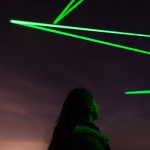Currently, there are more than 29.000 objects larger than 10 centimeters floating around the earth. It is space waste; parts of rockets and satellites. This waste can damage our satellites, with collisions creating more space debris and disturbing our digital communications. And nobody really knows how to fix it.
As part of Space Waste Lab, Dutch artist and innovator Daan Roosegaarde and his team of experts has created a large-scale light performance that follows this pieces of junk floating around in outer space. The vertical lines of lights visualize space waste on an altitude of 200 to 20.000 kilometers, highlighting its presence above our heads in a spectacular installation. The light performances will track space waste in real time and can be viewed after sunset on selected weekends. Examples from collision impacts and tangible pieces of space waste like a piece from the Hubble Space Telescope are provided by ESA and are on display in an accompanying living lab.
The living lab is supported by experts from European Space Agency ESA and is open to students and visitors to investigate how to upcycle space waste into sustainable products. Roosegaarde wants to enable visitors to experience space waste as a potential source for new creativity. Ideas from this living lab will be collected on Space Waste Lab postcards and exhibited inside the museum. At a symposium on January 19th, 2019 the first results will be announced, and the best ideas will be presented.


Space Waste Lab marks the first phase of a long-term project Space Waste and enables visitors to experience space waste not only as a threat but also as a potential source for new creativity. “We need to look at space in a better way. What is space waste, how can we fix it, and what is its potential?” says Roosegaarde. “Can we use space waste as a source material to 3D print houses on the moon, or use it to create artificial falling stars opposed to polluting fireworks?”

Franco Ongaro ESA Director of Technology, Engineering and Quality expresses that he is; “a strong believer in cooperation between technologists and artists,” it is important that we work together towards a solution.
“We believe in what we do as a service to society, but we are often unable to communicate its worth effectively enough. Artists not only communicate vision and feelings to the public but help us discover aspects of our work which we are often unable to perceive.”
The live installation, the first of which took place on 5 October in the Dutch city of Almere, saw arrows of neon green light projected into the sky to a distance of 125,000 to 136,000 miles. Next to the Space Waste Lab, a dedicated education, films, talks and expo programme entitled “Space @ KAF” will cover the wider context of Space.

Space Waste Lab is a part of Roosegaarde’s larger vision for Schoonheid, a Dutch word meaning both beauty and cleanliness, as in clean space, clean air, clean water, clean energy. Schoonheid is an activator for change, for citizens, makers, NGOs and governments to value and empower Schoonheid as a creative force to make clean environments.






